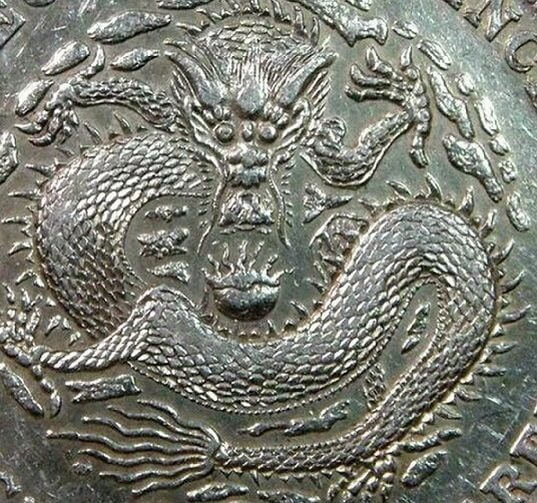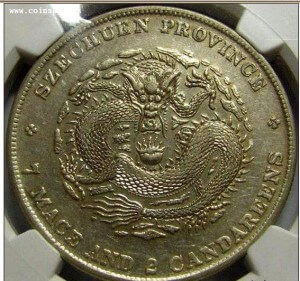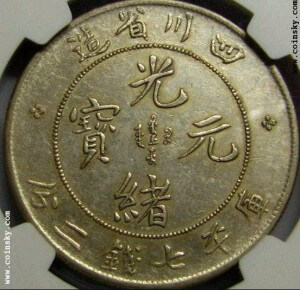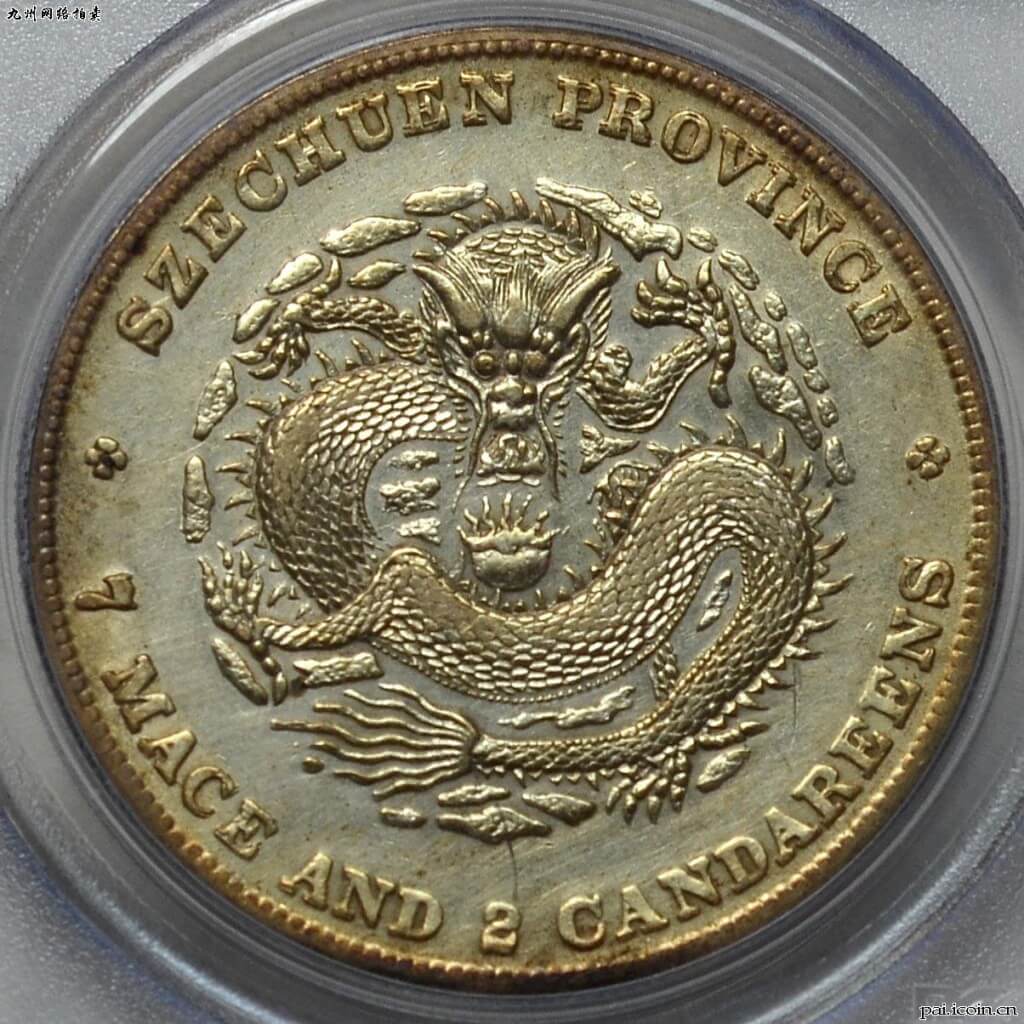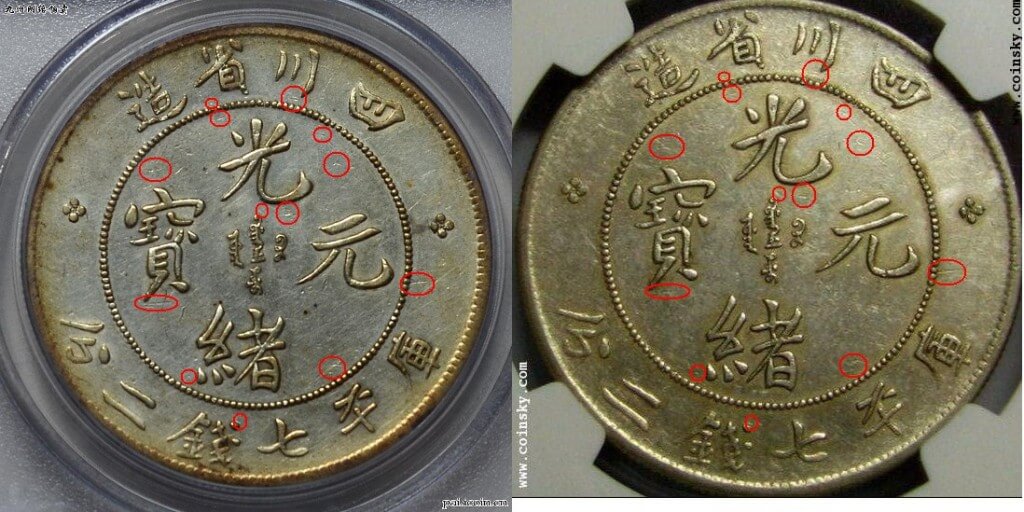A good friend from Hangzhou recently contacted me regarding a Chinese coin he was interested in purchasing. It was a beautiful but rather expensive Szechuan coin (¥100,000 RMB or about $16,400 USD at the time of writing), and he was unsure about the deal.
The Szechuan dollar my friend was considering to buy was a high grade sample of the rare “库 not connected” variety (四川光绪剑毛龙无头车). It had sharp details and was graded AU50 by NGC, however the coin had clearly been cleaned and my friend hoped for a discount.
I browsed past sales results when I was struck by the similitude between the coin my friend coveted and a Szechuen dollar sold at the Jiuzhou 2012 Summer Auction (九州2012夏季机制币、纸币拍卖专场). At first, I thought that the coin graded XF details by PCGS had been re-submitted to NGC in a bid for a more favorable grade, but I quickly verified that the coins’ obverse were distinct.
While carefully examining the reverse, I was troubled to find an identical scratch below the right side rosette. Despite the low resolution of the pictures sent by my friend, it was obvious this ought to be a circulation mark. Two coins of the same type often exhibit wear or weak strike in the same place, but identical circulation marks should never be observed: it would indeed imply both coins were randomly damaged in the exact same fashion while being handled by countless men and women through a century!
The scratches I highlighted on the picture above were damning evidences that both coins were very high level forgeries. The counterfeiters went to the trouble of striking different obverses, but were surprisingly lazy etching the same marks on the reverse. The replica is still stunning, and actually fooled two world-class grading agencies and the highly experienced Chinese coins collectors who bought them. It is especially troubling that without the inexplicable laziness of the counterfeiters, and a stroke of luck comparing pictures on the Internet, both fake coins would have most likely stayed undetected.
Once again, I will urge my dear readers to listen to their instinct when buying: if you are somehow hesitant about a deal, like my friend was, the best decision is often to walk away. It is also best to avoid buying cleaned or polished coins altogether, especially in high grade, as it is too convenient a camouflage for artificial aging.
While american collectors put an emphasis on pristine coins, with “brilliant flashy mint state cartwheel luster” being an often seen eBay selling point for Morgan dollars, chinese collectors seem to like heavily toned or corroded coins. Why do chinese coins collectors like their coins “dirty”?
The reason is that chinese collectors don’t have the same relation with coins as their american peers.
Serious american collectors usually get their coins conserved, graded and hermetically slabbed, then store them securely in a bank vault or a safe. They don’t usually manipulate their coins, to avoid damaging them – they are actually fragile investment instruments. It is therefore important to get top grade, “problem free” coins to eventually sell them at an higher price than competing collectors with lower grade coins.
Chinese collectors most often store their coins in albums or coin capsules so they can be seen and touched, and won’t hesitate to test if a coin is genuine by making it ring against another silver coin (which will make the american collector wince). Chinese collectors value the link to the past that a coin represents – the many hands it went through, the many provinces it crossed from transaction to transaction. Manipulating the coin is just a continuation of its unique story, and therefore doesn’t decrease its appeal to chinese collectors.
It is therefore logical that toning is highly regarded in China: it is the outcome of a long aging process. Silver will naturally oxydize and react chemically to the substances it is exposed to, and depending of its alloy composition and environment, its colour will vary through a whole gamut of complex hues. A toned coin shows its history in the most vibrant way – its colourful surface is a unique, beautiful testimony of all the places and times it has gone through. That’s why it’s not treated as “filth” but respectfully called 包奖 (bao jiang).
A coin expert can tell from which part of China originates a toned, buried dollar. Soil composition varies in the different provinces, and it affects the chemical process accordingly: for example, silver yuan with a verdigris toning usually come from the South, and black coins from the Northern provinces. This adds to the narrative of the coin and makes it more attractive.
Since toning is such an aesthetic and desirable sign of old age, clever collectors or dealers have found out many creative ways to fake it. Methods range from the “organic”, like letting a coin bask in the sunlight on one’s window-sill or forget it in an enveloppe, to the somewhat gross (china ink, nose grease, cigarette smoke…) and the industrial (chemicals).
Most of these methods can be spotted – window-sill toning will make the coin surface look more dull, cigarette or chemicals usually leave the coin durably stinky. Artificial toning is designed to deceive buyers by dissimulating slight flaws (light cleaning, hairlines) or in the worst case hide retooling, harsh cleaning (acid prevents coins from toning) or as part of the artificial aging process for fake coins. Forgery is an industry in China, so artificial toning will almost always be chemical in that case.
Some black deposits around the legend or the rim of an otherwise white coin are an hallmark of fake chinese coins. If you look carefully, the residues usually look like some kind of paint or varnish. The surface of the coin is covered with this black substance, then it is washed to make it look like the surface of an old, cleaned coin. Some other coins are bathed in a chemical that leave the coin covered with verdigris like deposits, but unlike genuine buried silver dollars, such a forgery will actually reek of whatever was used to obtain this result.
The dust, corrosion and toning on a beautiful coin are aesthetic reminders of all the people who hold it before us and will hold it long after we are gone. For chinese collectors, feeling the weight of time in the palm of one’s hand is worth a premium.
